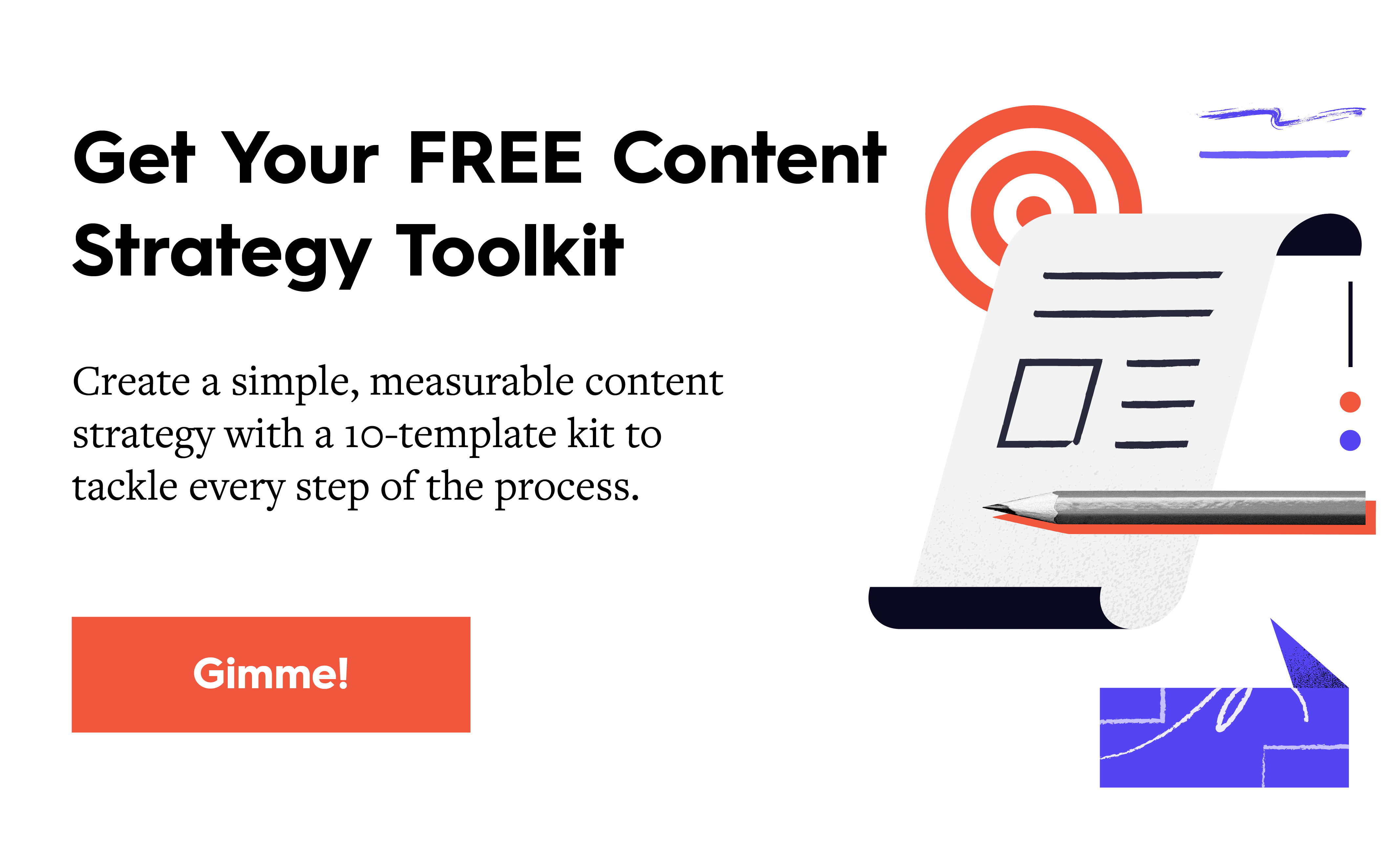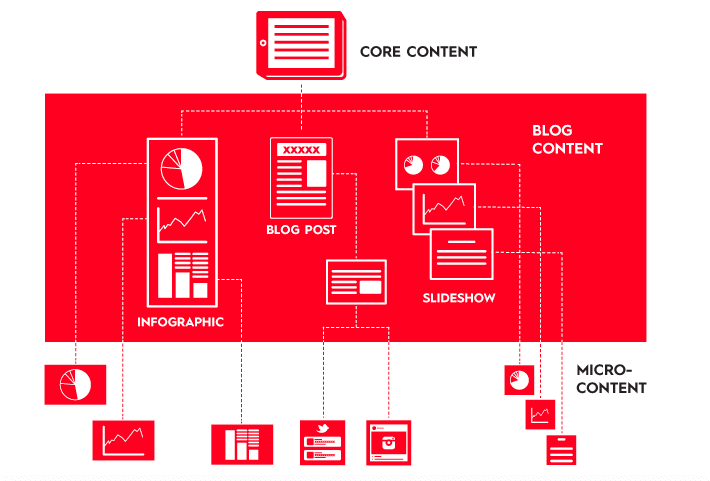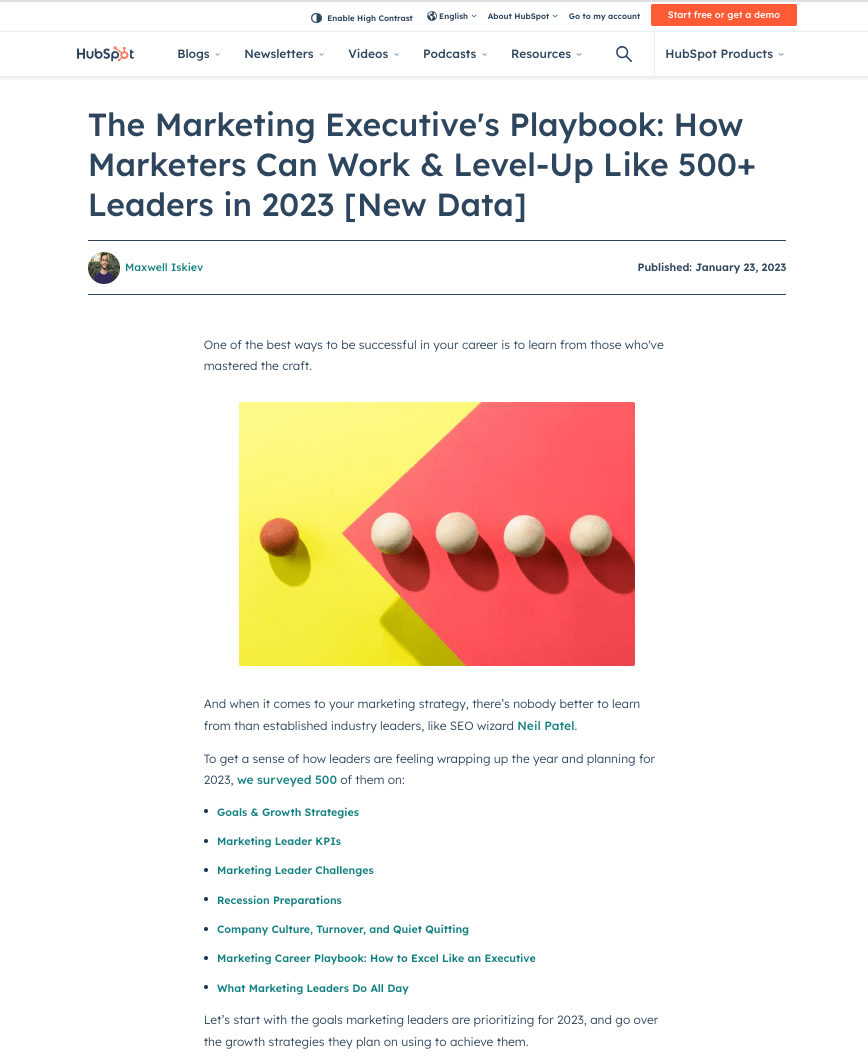Marketing is tough, especially when content marketing budgets are getting cut across the board. Not only do you need to make sure you’re creating the right content but you need to get the most from every piece of content you create. Of course, that can be a challenge when you’re trying to market to multiple audiences with different wants and needs. Fortunately, there is a smart hack you can use to create a large volume of tailored content with minimal effort. It’s called a divisible content strategy.

What Is a Divisible Content Strategy?
It’s a simple way to spin multiple pieces of marketing content out of one main piece. Here’s how it works:

Tier 1: You create one large piece of cornerstone content, such as:
- Guide
- Report
- Whitepaper
- Ebook
- Interactive
- Podcast
- Video
It works best when it’s a rich piece of content that comprehensively covers a topic.
Tier 2: You create a variety of supporting content based on that piece of cornerstone content, such as:
- Blogs
- Guest posts
- Infographics
- Videos
- Slideshows
- Etc.
This content is ideal to publish on various owned channels to promote the larger piece of content.
Tier 3: You create an additional batch of social microcontent to promote the cornerstone content and supporting content across social media, such as:
- Twitter threads
- Mini infographics
- Quotes
- Data Visualizations
- Highlights
- Image carousels
- Short videos
- Quick tips
There are many benefits to a divisible content strategy. It allows you to tell a consistent story across platforms. It helps you create more marketing content with less work. And it helps you maximize your reach and promotion. But one of the best things about it is that it allows you to create supporting content tailored for multiple audiences. In essence, the supporting content acts as a special doorway, encouraging all sorts of different people to step through and explore your larger content. The key, of course, is to tailor that content to make your audience want to know more.
5 Ways to Tailor Divisible Content For Your Audience
Naturally, if you want to reach different people, you need to take a different approach for each type of person. Here’s how to ensure the supporting content you create is interesting and relevant to your different audiences.
1) Find a pain point.
Pain points, problems, and challenges will always grab attention, and they can be one of the best starting points for a conversation. Whether you’re sharing relevant tips, data, or highlights, creating marketing content around pain points will always make your audience do a double-take—and swipe.
Tip: Create personas to understand what makes your audience tick, and see these 10 easy ways to turn pain points into content.
Example: To promote their 2023 Marketing & Industry Trends Report on Instagram, Hubspot shared the biggest challenges social media marketers make. This is a great way to highlight interesting data, speak to that specific niche (even though the report covers wide swaths of the marketing industry), and do it without having to create a whole new piece of content. (Bonus points for making them slide to see the data—and increase engagement in the process.)
View this post on Instagram
2) Find an emotional hook.
Similar to pain points, which are a specific emotion, any emotional hook will always stop someone’s scroll. The key is to understand what is relevant or relatable to them. If you’re not sure what would resonate best, think about how you might create content based on these emotions.
- Fear: What’s a statistic, alarming trend, or warning that might be relevant to them?
- Joy: What type of marketing content do they find exciting, interesting, or amusing? Memes, jokes, etc. can be a great way to connect.
- Relief: What time-saving tips or hacks can you share to help make their lives less stressful?
- Surprise: Is there any myth-busting insight in your content? Does it reveal a surprising truth? That’s a great way to catch their eye.
Again, think about the messages they want or need to hear.
Tip: Use empathy to think about your audience’s emotional needs. For more inspiration, see how these 15 brands turned empathy into great marketing content.
Example: Hubspot calls out classic myths about remote work to change leaders’ minds (and promote a deeper dive article about the subject).
View this post on Instagram
3) Tell an additional story.
Even if your cornerstone content covers a particular topic in depth, there are always ways go deeper. A simple data point in an ebook can become a full blog. A particular trend might inspire a whole new infographic. Creating additional content or providing additional information about a specific angle is a great way to deliver value to a specific audience. For example, after creating an e-book about the power of brand video, we might then write an article on how B2B tech marketers (a very specific audience) can use videos to connect with their audience.
Tip: It can also help to look at trending stories in your industry and see if there’s a connection. For example, if you’re in PR and a popular company recently suffered a PR crisis, you could write an article offering your tips on how to ensure your company doesn’t make the same mistake. That said, be thoughtful about what stories you’re chiming in on. See our tips to ensure you’re not newsjacking like a jackass.
Example: Hubspot’s 2023 Marketing & Industry Trends report contains plenty of interesting info for a variety of audiences, but Hubspot used the report to tell a specific story to a specific audience: marketing executives. By creating The Marketing Executive’s Playbook, they were able to use data from the report to give execs their own specific game plan, increasing the value of the report while expanding the story.

4) Choose their preferred format.
Different audiences consume content differently. For example, if you’re targeting a Gen Z entry-level employee, a TikTok video might be ideal. If you’re targeting a CMO, a well-researched blog article may be the right medium. Medium is also dictated by platform. If an e-book is your cornerstone content, you might target one group with a Twitter thread of the best insights and reach another audience with a short tip video on Instagram.
Tip: Find out which of these 13 types of visual content will work best for your story.
Example: Hubspot’s simple little Instagram quiz is a fun and engaging way to interact with marketers while encouraging them to check out an additional piece of content. Note: Quizzes like this are an easy thing to personalize for a specific niche audience, too.
View this post on Instagram
5) Share the relevant highlights.
People are busy, and they may not have the time to explore a full piece of content. That said, you can still provide a valuable service by condensing or extracting the most relevant information for a specific audience through something like an infographic or a series of tips.
Example: To promote their How to Reach Out to Influencers guide, Hubspot shares 6 tips to make it easy for marketers to connect with influencers. It’s a simple, snackable way to tailor content.
How to Ensure You’re Always Connecting with Your Audience
Whether you’re trying to reach broke college students, urban 30-somethings, or Fortune 500 CEOS, there are a few specific ways to make the most memorable impression with your audience.
- Consider their age. Different generations want different things. See our tips to connect with Gen X, Millennials, and Gen Z.
- Speak the way they speak. You don’t want to intimidate your audience or speak down to them. Make sure you’re speaking to them in a real, human voice—at their level.
- Use your personas to brainstorm. Personas help you get inside your audience’s mind, which is why they’re such a great tool to vet your ideas. If you can’t justify why your target audience would care about your idea, don’t produce it.
Of course, the best way to connect with your audience is to build a strong content strategy around their interests. (Download our free content strategy toolkit if you need help building yours.) That said, we know that takes time and effort that not every brand has. If you’re looking for the right partner to help, take a look at our FAQs or reach out. We’d love to help you connect with your audience.




